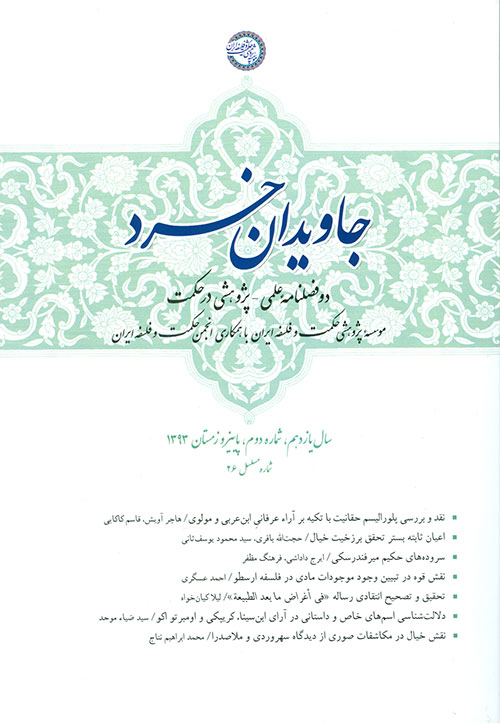Shams al-Dīn Samarqandī’s Double Version of Exposition of Mixed Syllogisms Which are Composed of Ḥaqīqī and Khārijī Propositions
Keywords:
Shams al-Dīn Samarqandī, khārijī, ḥaqīqī, mental, propositions, implicationAbstract
In this paper, we show that the extant manuscripts of Shams al-Dīn Samarqandī’s logical books Qisṭās al-afkār and Sharḥ al-Qisṭās exhibit a double version of exposition of mixed syllogisms which are composed of khārijī, ḥaqīqī and mental readings of quantified categorical propositions. This duble version presents different or even conflicting judgements on those mixed syllogisms. Because of the chronological precedence of one group of the manuscripts over the other, we call these two expositions "first version" and "second version," respectively. In addition, the manuscripts of both versions are divided into two groups. In one group, at the beginning of the section of propositions, when introducing the division of propositions into khārijī, ḥaqīqī and mental, a phrase is added to the manuscripts, which is only consistent with the contents of the second version. Since in the logical tradition in the Islamic world we have found the issue of mixed syllogisms composed of the three propositions only in these two works of Samarqandī, the importance of these two versions and of the added phrase is doubled and it must be examined whether the added phrase and the second version are from Samarqandī himself or from another scholar. In the present article, we will introduce the differences between the two versions and try to explain their relationship. In the end, we will critically edit the texts of these two versions in full.Extended Abstract Shams al-Dīn Muḥammad ibn Ashraf al-Ḥusaynī Samarqandī (d. 722/1322) has two important logical books: Qisṭās al-afkār and its self-commentary Sharḥ al-Qisṭās. Editions of the former have been published recently by Necmettin Pehlivan in 2014 and by the present author in 2020. When editing it, the present author noticed that the manuscripts of Qisṭās al-afkār can be divided into two groups which have different expositions of mixed syllogisms of the khārijī, ḥaqīqī and mental propositions. These two expositions do present conflicting judgements on the mixed syllogisms. In comparing these two versions of Qisṭās al-afkār with manuscripts of Sharḥ al-Qisṭās which were in our access then, we thought that Samarqandī had changed his ideas on the subject before authoring Sharḥ al-Qisṭās, and so we chose to insert the version verified in the commentary into the version of Qisṭās al-afkār. Now, by studying other manuscripts of the commentary, we notice that its manuscripts themselves also have the very two versions which were presented in the extant manuscripts of Qisṭās al-afkār. This shows that the change in Samarqandī’s views, if any, has occurred after authoring his commentary. Because of the chronological precedence of one group of the manuscripts of Sharḥ al-Qisṭās over the other group, we call these two manuscripts respectively "first version" and "second version".In the first version, Samarqandī distinguishes between affirmative and negative syllogisms:If a mixed syllogism of khārijī, ḥaqīqīand mental propositions is affirmative (i.e. if both premises are affirmative) then the reading of the conclusion (i. e. its being khārijī, ḥaqīqī or mental) follows the reading of the stronger premise. (Actually, in Samarqandī’s view in Qisṭās al-afkār, a khārijī reading of an affirmative proposition is stronger than its ḥaqīqī reading, which in turn is stronger than its mental reading). If the mixed syllogism of khārijī, ḥaqīqīand mental propositions is negative (i.e. if one of its premises is negative) then the reading of the conclusion follows the reading of the negative premise.In the second version, however, Samarqandī takes the reading of the conclusion of a mixed syllogism (whether it is affirmative or negative) to follow the reading of the stronger premise. So, he does not distinguish now between affirmative and negative syllogisms in his second version.Also, there is another difference between the two versions. In the first version, as we said above, he takes the affirmative khārijī, ḥaqīqī and mental propositions being sorted from the strongest to the weakest, and in the negative ones in the converse direction, from the weakest to the strongest. But in the second version, he restricts this verdict to I- and E-propositions, (i.e. affirmative particulars and negative universals). As to A- and O-propositions, (i.e. affirmative universals and negative particulars), he holds no implicational relation between the khārijī, ḥaqīqī and mental propositions.Actually, in most of the manuscripts of the second version, the difference discussed in the last paragraph is expressed explicitly at the beginnings of a section discussing the three readings of propositions, but we find two manuscripts of the second version that lack this explicit expression. So we can divide the manuscripts of Sharḥ al-Qisṭās into four groups: those containing the first version and lacking the explicit expression discussed above (23 manuscripts),those containing the second version but lacking the explicit expression (2 manuscripts),those containing both the first version and the explicit expression (3 manuscripts),those containing both the second version and the explicit expression (3 manuscripts). Chronologically, the first group is the oldest and the third is the latest copied manuscripts which are in the present author’s access now.Unfortunately, we do not have access to all the extant manuscripts of Sharḥ al-Qisṭās to see how much per cent of them belong to each of the four groups described above and how they are distributed from the viewpoint of the date of being copied. If we accessed them we could study their relations better and with much more exact. At the end of this paper, we will critically edit in full the texts of these two versions, with the hope that in the future more evidence will be found as to whether or not the second version can be really attributed to Samarqandī himself and if yes why he changed his ideas on the subject.





